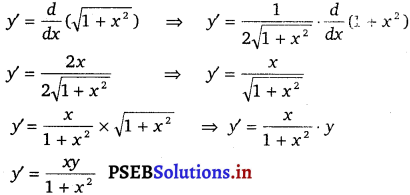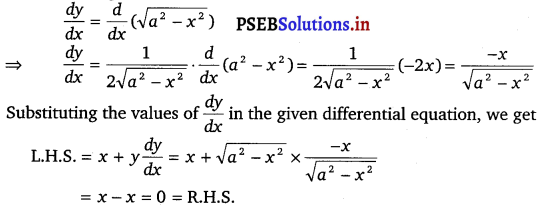Punjab State Board PSEB 12th Class Maths Book Solutions Chapter Differential Equations Ex 9.2 Textbook Exercise Questions and Answers.
PSEB Solutions for Class 12 Maths Chapter 9 Differential Equations Ex 9.2
Direction (1 – 10): In each of the questions verify that the given function (explicit or implicit) is a solution of the corresponding differential equation.
Question 1.
y = ex + 1 ; y” – y’ = 0 ,
Solution.
Given, y = ex + 1
Differentiating both sides of this equation w.r.t. x, we get
\(\frac{d y}{d x}\) = \(\frac{d}{d x}\) (ex + 1)
⇒ y’ = ex
Now, differentiating equation (i) w.r.t. x, we get
\(\frac{d}{d x}\) (y’) = \(\frac{d}{d x}\) (ex)
⇒ y” = ex
Substituting the values of y’ and y” in the given differential equation, we get the L.H.S. as
y” – y’ = ex – ex = 0 = R.H.S.
Thus, the given function in the solution of the corresponding differential equation.
Question 2.
y = x2 + 2x + C : y’ – 2x – 2 = 0
Solution.
Given, y = x2 + 2x + C
Differentiating both sides of this equation w.r.t x, we get
y’ = \(\frac{d}{d x}\) (x2 + 2x + C)
⇒ y’ = 2x+2 ax
Substituting the value of y’ in the given differential equation, we get
L.H.S. = y’ – 2x – 2 = 2x + 2 – 2x – 2 = 0 = R.H.S.
Hence, the given function is the solution of the corresponding differential equation.
![]()
Question 3.
y = cos x + C: y’ + sin x – 0
Solution.
Given, y = cos x + C
Differentiating both sides of this equation w.r.t. x, we get
y’ = \(\frac{d}{d x}\) (cos x + C)
=> y’ = – sin x dx
Substituting the value of y in the given differential equation, we get
L.H.S. y’ + sin x = – sin x + sin x = 0 = R.H.S.
Hence, the given function is the solution of the corresponding differential equation.
Question 4.
y = \(\sqrt{1-x^{2}}\); y’ = \(\frac{x y}{1+x^{2}}\)
Solution.
Given, y = \(\sqrt{1-x^{2}}\)
Differentiating both sides of this equation w.r.t. x, we get

∴ L.H.S. = R.H.S.
Hence, the given function is the solution of the corresponding differential equation.
![]()
Question 5.
y = Ax: xy’ = y, (x ≠ 0)
Solution.
Given, y = Ax
Differentiating both sides of this equation w.r.t. x, we get
y = -^-G4x) =^y = A
ax
Substituting the value of y’ in the given differential equation, we get
L.H.S. = xy’ = x . A = Ax = y= R.H.S.
Hence, the given function is the solution of the corresponding differential equation.
Question 6.
y = x sin x : xy’ = y + x \(\sqrt{x^{2}-y^{2}}\) (x ≠ 0 and x > y or x< – y)
Solution.
Given, y = x sin x
Differentiating both sides of this equation w.r.t. x, we get
y’ = \(\frac{d}{d x}\) (x sin x)
y’ = sin x . \(\frac{d}{d x}\) (x) + x . \(\frac{d}{d x}\) (sin x)
⇒ y = sin x + x cos x
Substituting the values of y in the given differential equation, we get
L.H.S. = xy = x (sin x + x cos x)
= x sin x + x2 cos x
= y + x2 . \(\sqrt{1-\sin ^{2} x}\)
= y + x2 \(\sqrt{1-\left(\frac{y}{x}\right)^{2}}\)
= y + x \(\sqrt{y^{2}-x^{2}}\) = R.H.S
Hence, the given function is the solution of the corresponding differential equation.
![]()
Question 7.
xy = log y + C : y’ = \(\frac{y^{2}}{1-x y}\) (xy ≠ 1)
Solution.
Given, xy = log y + C
Differentiating both sides of this equation w.r.t. x, we get
\(\frac{d}{d x}\) (xy) = \(\frac{d}{d x}\) (log y)
⇒ y . \(\frac{d}{d x}\) (x) + x . \(\frac{d y}{d x}\) = \(\frac{1}{y}\) \(\frac{d y}{d x}\)
⇒ y + xy’ = \(\frac{1}{y}\) y’
⇒ y2 + xy y’ = y’
⇒ (xy – 1) y’ = – y2
⇒ y’ = \(\frac{y^{2}}{1-x y}\)
.-. L.H.S. = R.H.S.
Hence, the given function is the solution of the corresponding differential equation.
Question 8.
y – cos y = x : (y sin y + cos y + x) y’ = y
Solution.
Given, y – cos y = x …………(i)
Differentiating both sides of this equation w.r.t. x, we get
\(\frac{d y}{d x}\) – \(\frac{d}{d x}\) (cos y) = \( \frac{d y}{d x} (x)\)
⇒ y’ + sin y . y’ = 1
⇒ y’ (1 + sin y) = 1
⇒ y’ = \(\frac{1}{1+\sin y}\)
Substituting the value of y in equation, we get
L.H.S = (y sin y + cos y + x) y’
= (y sin y + cos y + y – cos y) × \(\frac{1}{1+\sin y}\)
= y (1 + sin y) \(\frac{1}{1+\sin y}\)
= y = R.H.S.
Hence, the given function is the solution of the corresponding differential equation.
![]()
Question 9.
x + y = tan-1 y : y2 y’ + y2 + 1 = 0
Solution.
Given, x + y = tan-1 y
Differentiating both sides of this equation w.r.t. x, we get

Substituting the values of y’ in the given differential equation, we get
L.H.S = y2 y’ + y2 + 1
= y2 \(\left[\frac{-\left(1+y^{2}\right)}{y^{2}}\right]\) + y2 + 1
= – 1 – y2 + y2 + 1 = 0
= R.H.S
Hence, the given function is the solution of the corresponding differential equation.
Question 10.
y = \(\sqrt{a^{2}-x^{2}}\), x ∈ (- a, a): x + y \(\frac{d y}{d x}\) = 0, (y ≠ 0)
Solution.
Given, y = \(\sqrt{a^{2}-x^{2}}\)
Differentiating both sides of this equation w.r.t. x, we get

Hence, the given function is the solution of the corresponding differential equation.
![]()
Direction (11 – 12) :
Choose the correct answer.
Question 11.
The number of arbitrary constants in the general solution of a differential equation of fourth order is
(A) Zero
(B) 2
(C) 3
(D) 4
Solution.
We know that the number of constants in the general solution of a differential equation of order n is equal to its order. Therefore, the number of constants in the general equation of fourth order differential equation is four.
Hence, the correct answer is (D).
![]()
Question 12.
The number of arbitrary constants in the particular solution of a differential equation of third order is
(A) 3
(B) 2
(C) 1
(D) zero
Solution.
In a particular solution of a differential equation, there are no arbitrary constants.
Hence, the correct answer is (D).
